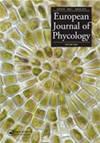蓝藻(绿藻科,绿藻门)叶绿体全基因组的形态特征、系统发育及比较分析
IF 1.7
4区 生物学
Q2 MARINE & FRESHWATER BIOLOGY
引用次数: 0
摘要
摘要:长毛毛藻(Chaetophora lobata)是毛毛藻属的模式种。澄清其物种鉴定、系统发育关系和质体特征有助于该属植物的分类修订和进化研究。本研究详细介绍了该植物的形态、培养、系统发育分析、系统基因组学和比较基因组学。基于核rDNA和叶绿体蛋白编码基因的完整形态描述和系统发育分析是鉴定野田菁的可靠依据。此外,采用从头测序方法确定了222 213 bp的叶绿体基因组,该基因组与所有其他毛藻成员一样缺乏反向重复。结果表明,紫叶甘蓝叶绿体DNA (cpDNA)富含at(68.2%),由67个蛋白质编码基因组成,其中62个基因编码在正链上,5个基因编码在负链上,且分布不均衡。此外,还标注了28个tRNA基因、3个rRNA基因、16个内含子和18个假定的开放阅读框(orf)。在psaA和atpI基因之间,8个orf排成一行,占据约18 kbp,在9个基因中注释了16个内含子(14个I类内含子和2个II类内含子)。6个基因含有9个内含子orf。同源性和重排分析表明Chaetophora sp.与C. lobata亲缘关系较近。替代率估计表明,毛藻的cpDNA处于纯化选择状态,大多数物种处于相似的进化压力下。这些发现有助于推进毛藻目的分类和系统发育研究。本文章由计算机程序翻译,如有差异,请以英文原文为准。
Complete chloroplast genome of the green alga Chaetophora lobata (Chlorophyceae, Chlorophyta): morphological features and phylogenetic and comparative analysis
ABSTRACT Chaetophora lobata is the type species of the polyphyletic genus Chaetophora. Clarification of its species identification, phylogenetic relationships, and plastome characteristics is helpful for taxonomic revisions and evolutionary studies of this genus. This study presents detailed information on morphology, culture, phylogenetic analysis, phylogenomics and comparative genomics of C. lobata. The complete morphological description and phylogenetic analyses based on nuclear rDNA and chloroplast protein-coding genes were robust for the identification of C. lobata. Moreover, de novo sequencing was used to determine the 222 213 bp chloroplast genome, which lacked inverted repeats as in all other members of the Chaetophorales. The chloroplast DNA (cpDNA) of C. lobata was found to be AT-rich (68.2%), consisting of 67 protein-coding genes, among which 62 genes were encoded on the plus strand and five genes were encoded on the minus strand with significant imbalance in distribution. Additionally, 28 tRNA genes, three rRNA genes, 16 introns and 18 putative open reading frames (ORFs) were annotated. Eight ORFs arranged in a row occupied about 18 kbp between psaA and atpI genes, and 16 introns (14 group I introns and 2 group II introns) were annotated in nine genes. Six genes contained nine intronic ORFs. Synteny and rearrangements analysis clearly showed the closest relationships between Chaetophora sp. and C. lobata. Substitution rate estimation indicated that the cpDNA of Chaetophorales was under purifying selection and most species were under similar evolutionary pressure. These findings can help advance research on the taxonomy and phylogeny of the order Chaetophorales.
求助全文
通过发布文献求助,成功后即可免费获取论文全文。
去求助
来源期刊

European Journal of Phycology
生物-海洋与淡水生物学
CiteScore
4.80
自引率
4.20%
发文量
37
审稿时长
>12 weeks
期刊介绍:
The European Journal of Phycology is an important focus for the activities of algal researchers all over the world. The Editors-in-Chief are assisted by an international team of Associate Editors who are experts in the following fields: macroalgal ecology, microalgal ecology, physiology and biochemistry, cell biology, molecular biology, macroalgal and microalgal systematics, applied phycology and biotechnology. The European Journal of Phycology publishes papers on all aspects of algae, including cyanobacteria. Articles may be in the form of primary research papers and reviews of topical subjects.
The journal publishes high quality research and is well cited, with a consistently good Impact Factor.
 求助内容:
求助内容: 应助结果提醒方式:
应助结果提醒方式:


